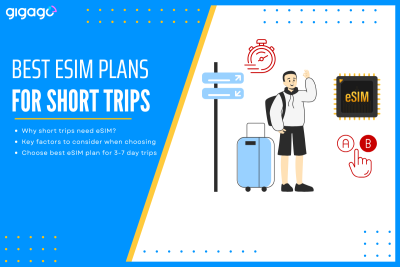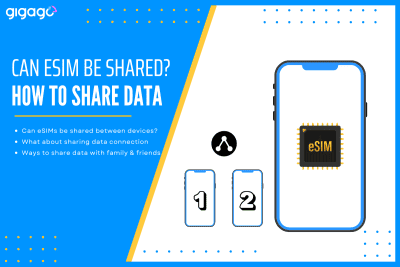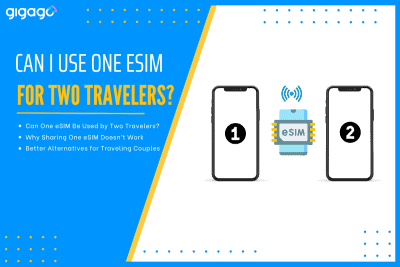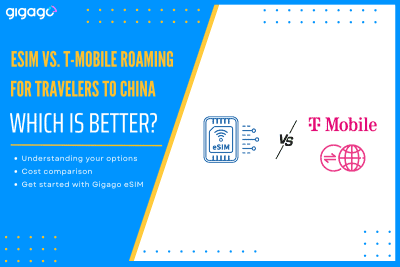Traveling for a short trip, typically for 3- to 7-days, drastically changes the rules of connectivity. The traditional solutions like expensive carrier roaming or time-consuming local SIM buying are simply impractical when time time is precious. This is where eSIMs take the picture. The eSIM (embedded because it is a digital solution that solves the […]
How to get the internet while traveling without buying a SIM card
When traveling abroad, we need Internet to open Maps, book a ride or text family that we arrive safely. Using a plastic SIM card either travel or local, is a regular option among travelers, but it is not the only way or the easiest. This guide shows simple, proven ways to get the Internet while traveling without buying a SIM card.

In this article
I. Why should you travel abroad without SIM?
There are many reasons why you should travel without SIM, but three most noticeable ones are:
1. Skip airport queues and language barriers
Buying and activating a physical SIM card can be complicated and time-consuming, especially if you buy it in the SIM shops at the airport where it can be crowded and plans are often explained in a language you may not speak. It is also inconvenient if you travel to multiple countries on a trip because you need to buy SIMs for each.
Going SIM-free allows you to walk straight to baggage claim and out the door.
2. Avoid hidden roaming bills
International roaming from your home carrier can cost dollars per MB. Alternative options will help you avoid shocks on your next bill.
3. Better security
If you use free WiFi like in hotels or cafes, your personal data can pose security risks. Using other internet options can provide a safer and more secure connection.
II. 3 Effective ways to get internet when travel without SIM
1. Public WiFi
Public WiFi is often free in cafés, hotels, airports, and even trains. It is good for light use, but speeds change often and open networks are not very safe unless you use a VPN. You should always verify the legitimacy of the networks before entering personal sensitive information.
2. Portable WiFi
Portable WiFi is a small battery-powered router that you rent or buy. It shares 4G/LTE with 5–10 devices which is a good choice for families. Using a pocket WiFi, you can get fast and stable internet without the need to buy a SIM card. Most pocket WiFi has a long battery life that you can use for hours without interruption. However, drawbacks of this option is that you must carry and charge another gadget, pay a deposit, and return it on time.
3. eSIM (embedded SIM)
eSIM is a tiny chip embedded in the mainboard of mobile devices. It removes the need to swap in and out SIM cards. With an eSIM, you can buy and activate a data plan 100% online without going to physical SIM stores. This saves effort and time for travelers. Travelers who plan to travel to multiple countries on their trips now can buy one multi-country eSIM without switching SIMs.
III. Compare Public WiFi vs. Portable WiFi vs. eSIM
| Feature | Public Wi-Fi | Pocket Wi-Fi | eSIM |
| Cost to start | Free | Rental fee + deposit | Plans from $1.50 |
| Speed | Can be slow | 4G/LTE | 4G/LTE |
| Security | Low | High (own password) | High (carrier network) |
| Extra gear | None | Router + cable | None |
| Works in many countries | Only if each place has Wi-Fi | Depends on device plan | Yes, choose regional/global |
| Device compatibility | works on all WiFi enabled devices | Work on all devices allowing multiple connections | Only eSIM-compatible devices |
| Share with other devices | Sometimes | Yes (up to 10) | Yes (phone hotspot) |
| Battery | No battery needed | Need to charge and battery life varies | No battery requied. |
| Best for | Travelers without little Internet needs or are on budget | Group travel, or business travelers who need high-speed internet | almost travelers with eSIM supported devices |
IV. How to choose the right option for you – Consider 5 factors
When deciding on the best connectivity option for traveling abroad, it’s essential to evaluate these five primary factors:
1. Trip Length and Style
The duration and nature of your trip play a big role in determining the right option. For a short weekend city break, free Wi-Fi at cafes or hotels combined with a small eSIM data plan should suffice. However, for a longer trip, such as a one-month rail journey across multiple countries, it is more practical to invest in portable Wi-Fi devices or regional eSIMs. These options ensure seamless connectivity and reduce the hassle of switching networks frequently.
2. Data Usage and Number of Devices
Your data needs depend on how many devices you will connect and what you will use them for. If you only need basic connectivity for checking emails and using maps on a single phone, a small eSIM with 1-3 GB of data is adequate. On the other hand, if you are traveling with a family and plan to stream videos or use multiple devices like tablets and laptops, a portable Wi-Fi device or a larger eSIM data bundle is a better choice to meet your higher consumption needs.
3. Cost vs. Convenience
Balancing your budget against ease of use is crucial. Free Wi-Fi is the most economical choice, but it’s often unreliable and limited in availability. For business travelers or those who need to stay constantly connected, paying for roaming services or an eSIM is a worthwhile investment, as it offers the convenience of being online anytime, anywhere, without interruption.
4. Safety and Security Needs
If you plan to access sensitive information, such as work servers or online banking, security should be a priority. Open public Wi-Fi networks are risky and can expose your data to cyber threats. In such cases, using a secure eSIM or a password-protected portable Wi-Fi device is a much safer alternative, ensuring your personal and professional data remains protected.
5. Backup Plan
Always have a contingency plan for staying online in case your primary option fails. For instance, carry both an eSIM for reliable connectivity and be aware of locations that offer free Wi-Fi, like cafes or hotels. Having at least two ways to connect ensures you’re prepared for unexpected issues, such as poor network coverage or device malfunctions.
By carefully evaluating these factors, you can select the connectivity option that best suits your travel needs, ensuring a hassle-free and secure online experience.
V. Travel with SIM-free from Gigago
With a Gigago eSIM you step off the plane, switch on data roaming for the eSIM, and you are connected before the luggage carousel stops. No plastic, no paperwork, no surprises – just smooth internet wherever the journey takes you.
Here is what makes Gigago eSIMs worth your try:
- Instant delivery: You can buy any time, receive the QR code in minutes through email or app.
- Wide choice: The plans are diversifying, including single-country, regional, and global plans for over 200 destinations.
- Easy setup: on your eSIM-supported and unlocked phone, go to Settings > Mobile Data > Add eSIM > Scan QR code. The whole process takes about 2 minutes. After arrival, you turn on data roaming on the eSIM line to start enjoying mobile data abroad.
- Keep your normal SIM: Use it for calls and texts, set the Gigago eSIM as “Mobile Data Only”.
- 24/7 support: Chat, email, or WhatsApp if you need support while on the road.



